Conflict Management in Multicultural Teams: A Reflective Essay
VerifiedAdded on 2023/06/03
|8
|1500
|405
Essay
AI Summary
This reflective essay discusses conflict management within organizations, focusing on personal experiences and the application of managerial skills to resolve conflicts. It highlights an incident involving a multicultural team and the challenges faced due to differing perspectives. The essay details the use of the collaborating technique, including preparation, understanding the situation, reaching an agreement, and preventing future conflicts. Various conflict management strategies such as accommodating, avoiding, compromising, and competing are explored, emphasizing the importance of interpersonal skills, stress management, ethical behavior, teamwork, communication, and motivational skills in effective conflict management. The essay concludes that conflict management is crucial for organizational peace and productivity, offering valuable insights for future application.
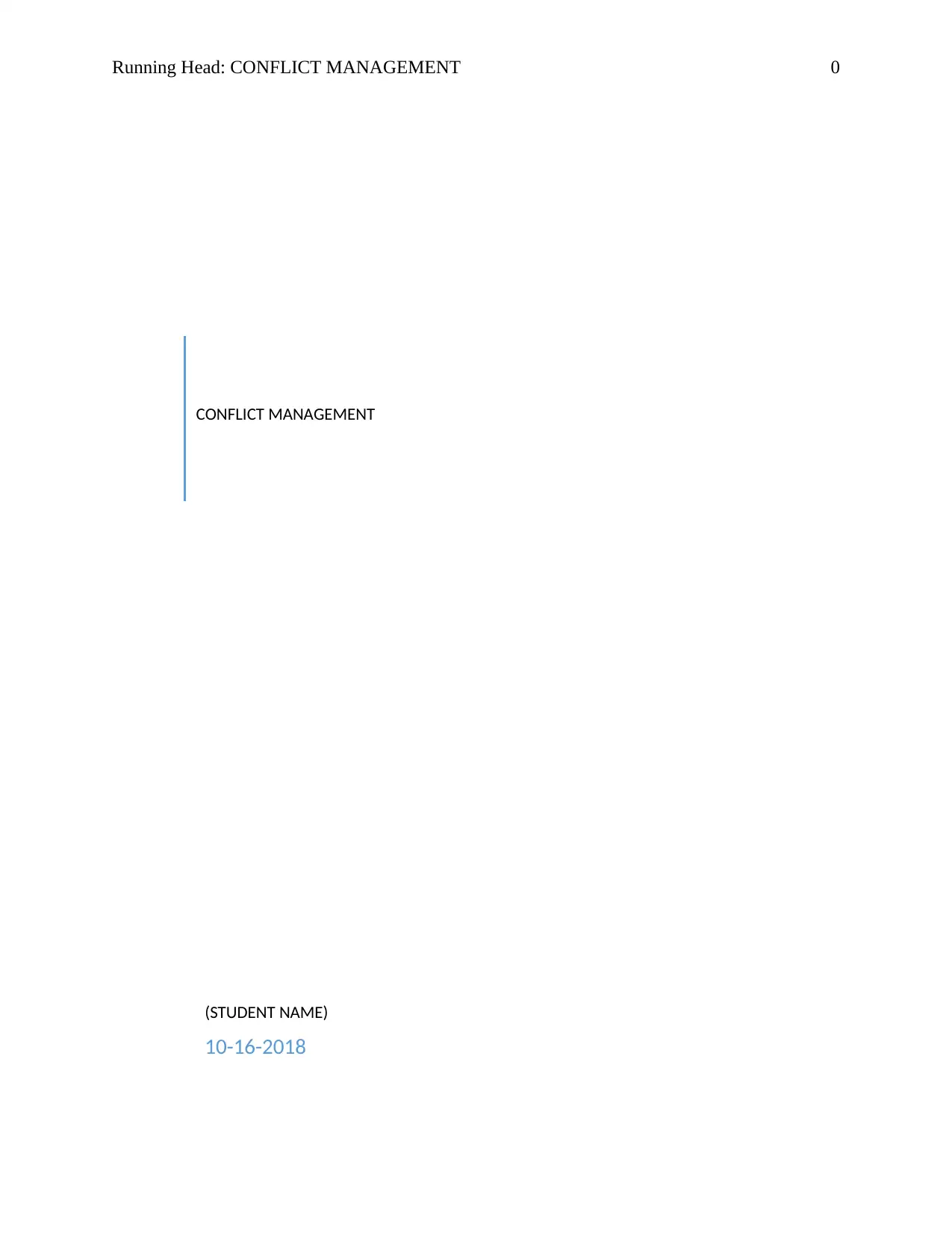
Running Head: CONFLICT MANAGEMENT 0
CONFLICT MANAGEMENT
(STUDENT NAME)
10-16-2018
CONFLICT MANAGEMENT
(STUDENT NAME)
10-16-2018
Paraphrase This Document
Need a fresh take? Get an instant paraphrase of this document with our AI Paraphraser
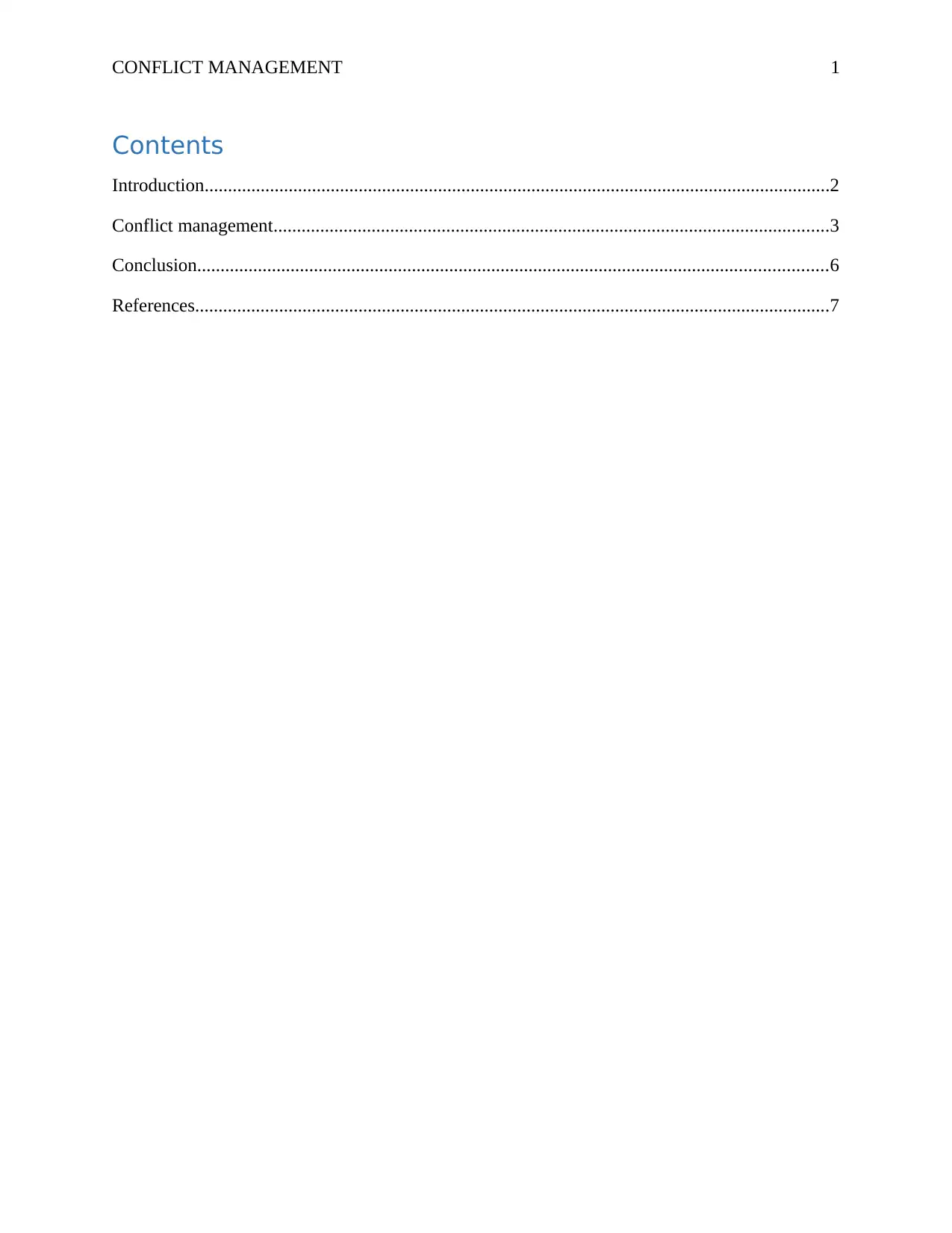
CONFLICT MANAGEMENT 1
Contents
Introduction......................................................................................................................................2
Conflict management.......................................................................................................................3
Conclusion.......................................................................................................................................6
References........................................................................................................................................7
Contents
Introduction......................................................................................................................................2
Conflict management.......................................................................................................................3
Conclusion.......................................................................................................................................6
References........................................................................................................................................7

CONFLICT MANAGEMENT 2
Introduction
In this reflective paper, the conflicts in organization and way to resolve those conflicts
will be discussed. The paper will include personal experience or incident occurred in the
organization and how different managerial skills were used to resolve those conflicts. Moreover,
the effectiveness of learned methods and steps of conflict management were considered and the
way they can support in near future. Conflict management is necessary for organizations in
today’s world, due to an increase in multicultural teams, and companies becoming more wide
and globalized. Conflicts increase where people with different cultures work together as a team
(Wallensteen, 2015).
Introduction
In this reflective paper, the conflicts in organization and way to resolve those conflicts
will be discussed. The paper will include personal experience or incident occurred in the
organization and how different managerial skills were used to resolve those conflicts. Moreover,
the effectiveness of learned methods and steps of conflict management were considered and the
way they can support in near future. Conflict management is necessary for organizations in
today’s world, due to an increase in multicultural teams, and companies becoming more wide
and globalized. Conflicts increase where people with different cultures work together as a team
(Wallensteen, 2015).
⊘ This is a preview!⊘
Do you want full access?
Subscribe today to unlock all pages.

Trusted by 1+ million students worldwide
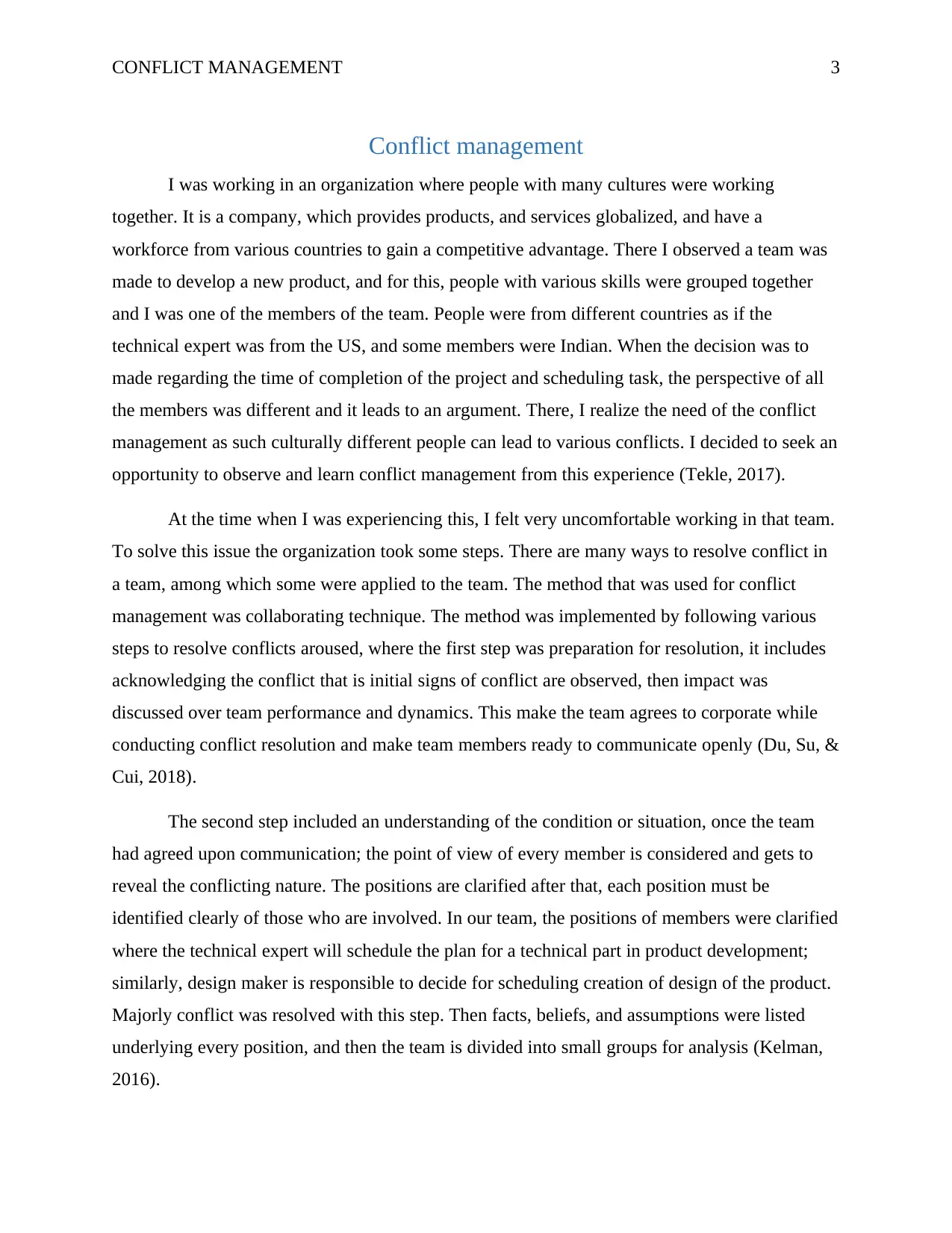
CONFLICT MANAGEMENT 3
Conflict management
I was working in an organization where people with many cultures were working
together. It is a company, which provides products, and services globalized, and have a
workforce from various countries to gain a competitive advantage. There I observed a team was
made to develop a new product, and for this, people with various skills were grouped together
and I was one of the members of the team. People were from different countries as if the
technical expert was from the US, and some members were Indian. When the decision was to
made regarding the time of completion of the project and scheduling task, the perspective of all
the members was different and it leads to an argument. There, I realize the need of the conflict
management as such culturally different people can lead to various conflicts. I decided to seek an
opportunity to observe and learn conflict management from this experience (Tekle, 2017).
At the time when I was experiencing this, I felt very uncomfortable working in that team.
To solve this issue the organization took some steps. There are many ways to resolve conflict in
a team, among which some were applied to the team. The method that was used for conflict
management was collaborating technique. The method was implemented by following various
steps to resolve conflicts aroused, where the first step was preparation for resolution, it includes
acknowledging the conflict that is initial signs of conflict are observed, then impact was
discussed over team performance and dynamics. This make the team agrees to corporate while
conducting conflict resolution and make team members ready to communicate openly (Du, Su, &
Cui, 2018).
The second step included an understanding of the condition or situation, once the team
had agreed upon communication; the point of view of every member is considered and gets to
reveal the conflicting nature. The positions are clarified after that, each position must be
identified clearly of those who are involved. In our team, the positions of members were clarified
where the technical expert will schedule the plan for a technical part in product development;
similarly, design maker is responsible to decide for scheduling creation of design of the product.
Majorly conflict was resolved with this step. Then facts, beliefs, and assumptions were listed
underlying every position, and then the team is divided into small groups for analysis (Kelman,
2016).
Conflict management
I was working in an organization where people with many cultures were working
together. It is a company, which provides products, and services globalized, and have a
workforce from various countries to gain a competitive advantage. There I observed a team was
made to develop a new product, and for this, people with various skills were grouped together
and I was one of the members of the team. People were from different countries as if the
technical expert was from the US, and some members were Indian. When the decision was to
made regarding the time of completion of the project and scheduling task, the perspective of all
the members was different and it leads to an argument. There, I realize the need of the conflict
management as such culturally different people can lead to various conflicts. I decided to seek an
opportunity to observe and learn conflict management from this experience (Tekle, 2017).
At the time when I was experiencing this, I felt very uncomfortable working in that team.
To solve this issue the organization took some steps. There are many ways to resolve conflict in
a team, among which some were applied to the team. The method that was used for conflict
management was collaborating technique. The method was implemented by following various
steps to resolve conflicts aroused, where the first step was preparation for resolution, it includes
acknowledging the conflict that is initial signs of conflict are observed, then impact was
discussed over team performance and dynamics. This make the team agrees to corporate while
conducting conflict resolution and make team members ready to communicate openly (Du, Su, &
Cui, 2018).
The second step included an understanding of the condition or situation, once the team
had agreed upon communication; the point of view of every member is considered and gets to
reveal the conflicting nature. The positions are clarified after that, each position must be
identified clearly of those who are involved. In our team, the positions of members were clarified
where the technical expert will schedule the plan for a technical part in product development;
similarly, design maker is responsible to decide for scheduling creation of design of the product.
Majorly conflict was resolved with this step. Then facts, beliefs, and assumptions were listed
underlying every position, and then the team is divided into small groups for analysis (Kelman,
2016).
Paraphrase This Document
Need a fresh take? Get an instant paraphrase of this document with our AI Paraphraser

CONFLICT MANAGEMENT 4
The third step includes reaching an agreement, with deciding on the best action to be
taken, considering all assumptions and facts. In case any further evaluation and analysis are
needed, evaluation and decision-making tools and methods are defined that needs to be
employed (Kelman, 2016).
The last step includes prevention from further conflict; the methods were prepared to
prevent conflicts, for this, behavior and skills were learned by the team members. This considers
immediately dealing with conflicts, open communication, practice to conduct clear
communication, practice active listening, practice recognizing assumptions, not making conflicts
personal, consider actionable solutions, demonstrating respect, not taking team issues outside the
team (Kelman, 2016).
While taking the experience, the relevance of the conflict management was learned.
Conflicts are the consequences of the difference in thought process, opinions, interests, attitude,
needs, dissimilar ways of individuals working together in an organization, team, or in the group.
The conduct of conflicts can, not only hamper the organizational efficiency of performing
activities, but also personal lives are disrupted. If a conflict is conducted, the work is slow down
or stopped their itself, resulting into the low productivity of human resource, the work
environment is also harmed because it not only influence the people involved in conflicts but
other speculators as well and will also decrease their productivity for the time being. At times,
the conflicts can be reached to an extent that it becomes personal among some people, which can
affect in form of anxiety, depression, or increase stress in the organization. The conflicts will
also hamper the reputation of the firm, if the conflicts are getting out of the organization in
public, due to which employees retention becomes a challenge for the organization. To prevent
these issues, an organization must adopt conflict management methods, because prevention is
better to avoid damage rather than curing these issues (Duncan, 2015).
Most important conflict management strategies or techniques that I learned after this
incident and can be used in future in case conflict is observed, those strategies were, firstly,
accommodating, this strategy is adopted or occurs where a party wants to maintain peace or
consider the issue as minor by giving another party what he or she expects. Secondly, avoiding
strategy, it includes putting off conflicts, or ignoring, or delaying the conflict. The avoider is
expecting a problem to be resolved without confronting. In some situation, considering avoiding
The third step includes reaching an agreement, with deciding on the best action to be
taken, considering all assumptions and facts. In case any further evaluation and analysis are
needed, evaluation and decision-making tools and methods are defined that needs to be
employed (Kelman, 2016).
The last step includes prevention from further conflict; the methods were prepared to
prevent conflicts, for this, behavior and skills were learned by the team members. This considers
immediately dealing with conflicts, open communication, practice to conduct clear
communication, practice active listening, practice recognizing assumptions, not making conflicts
personal, consider actionable solutions, demonstrating respect, not taking team issues outside the
team (Kelman, 2016).
While taking the experience, the relevance of the conflict management was learned.
Conflicts are the consequences of the difference in thought process, opinions, interests, attitude,
needs, dissimilar ways of individuals working together in an organization, team, or in the group.
The conduct of conflicts can, not only hamper the organizational efficiency of performing
activities, but also personal lives are disrupted. If a conflict is conducted, the work is slow down
or stopped their itself, resulting into the low productivity of human resource, the work
environment is also harmed because it not only influence the people involved in conflicts but
other speculators as well and will also decrease their productivity for the time being. At times,
the conflicts can be reached to an extent that it becomes personal among some people, which can
affect in form of anxiety, depression, or increase stress in the organization. The conflicts will
also hamper the reputation of the firm, if the conflicts are getting out of the organization in
public, due to which employees retention becomes a challenge for the organization. To prevent
these issues, an organization must adopt conflict management methods, because prevention is
better to avoid damage rather than curing these issues (Duncan, 2015).
Most important conflict management strategies or techniques that I learned after this
incident and can be used in future in case conflict is observed, those strategies were, firstly,
accommodating, this strategy is adopted or occurs where a party wants to maintain peace or
consider the issue as minor by giving another party what he or she expects. Secondly, avoiding
strategy, it includes putting off conflicts, or ignoring, or delaying the conflict. The avoider is
expecting a problem to be resolved without confronting. In some situation, considering avoiding
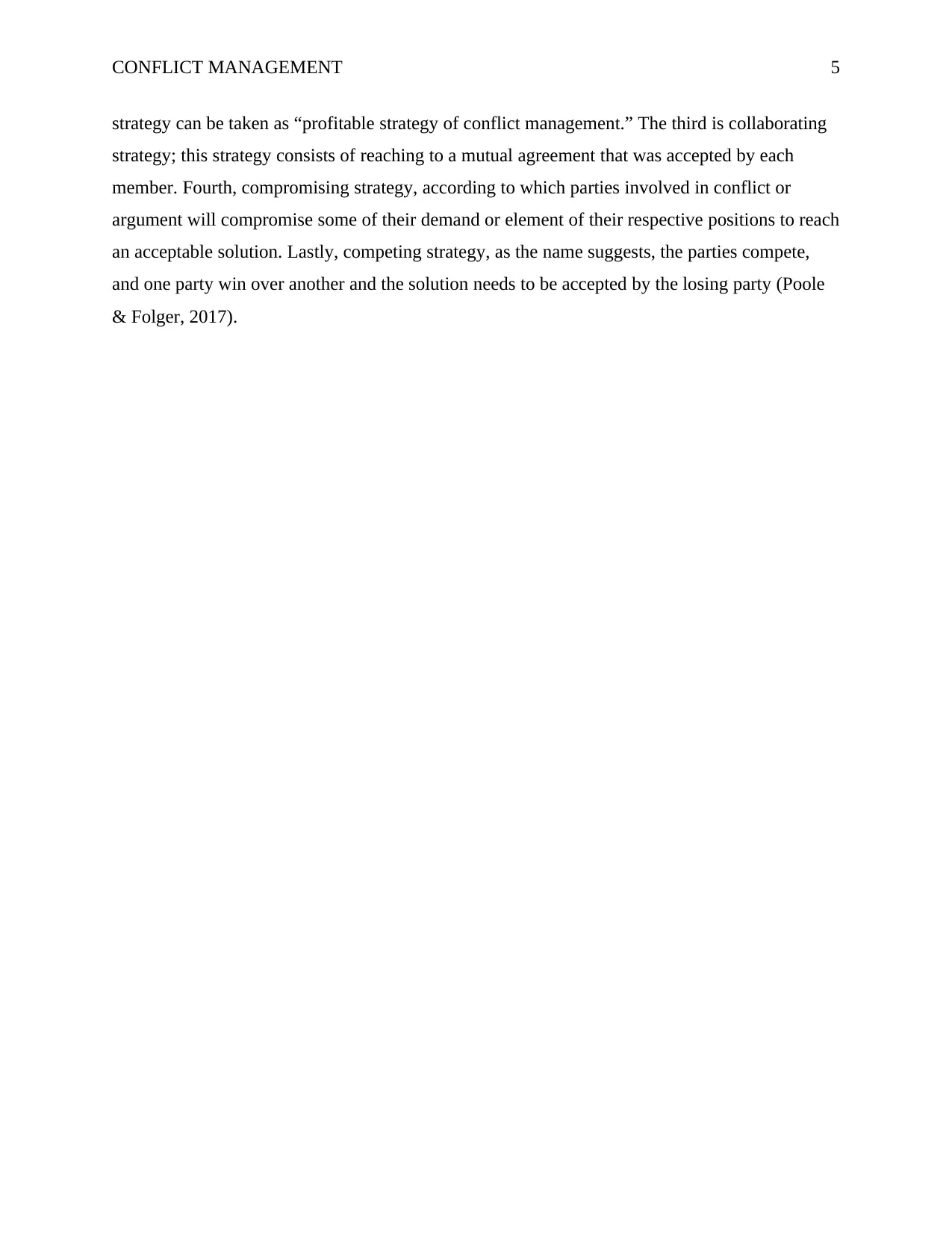
CONFLICT MANAGEMENT 5
strategy can be taken as “profitable strategy of conflict management.” The third is collaborating
strategy; this strategy consists of reaching to a mutual agreement that was accepted by each
member. Fourth, compromising strategy, according to which parties involved in conflict or
argument will compromise some of their demand or element of their respective positions to reach
an acceptable solution. Lastly, competing strategy, as the name suggests, the parties compete,
and one party win over another and the solution needs to be accepted by the losing party (Poole
& Folger, 2017).
strategy can be taken as “profitable strategy of conflict management.” The third is collaborating
strategy; this strategy consists of reaching to a mutual agreement that was accepted by each
member. Fourth, compromising strategy, according to which parties involved in conflict or
argument will compromise some of their demand or element of their respective positions to reach
an acceptable solution. Lastly, competing strategy, as the name suggests, the parties compete,
and one party win over another and the solution needs to be accepted by the losing party (Poole
& Folger, 2017).
⊘ This is a preview!⊘
Do you want full access?
Subscribe today to unlock all pages.

Trusted by 1+ million students worldwide
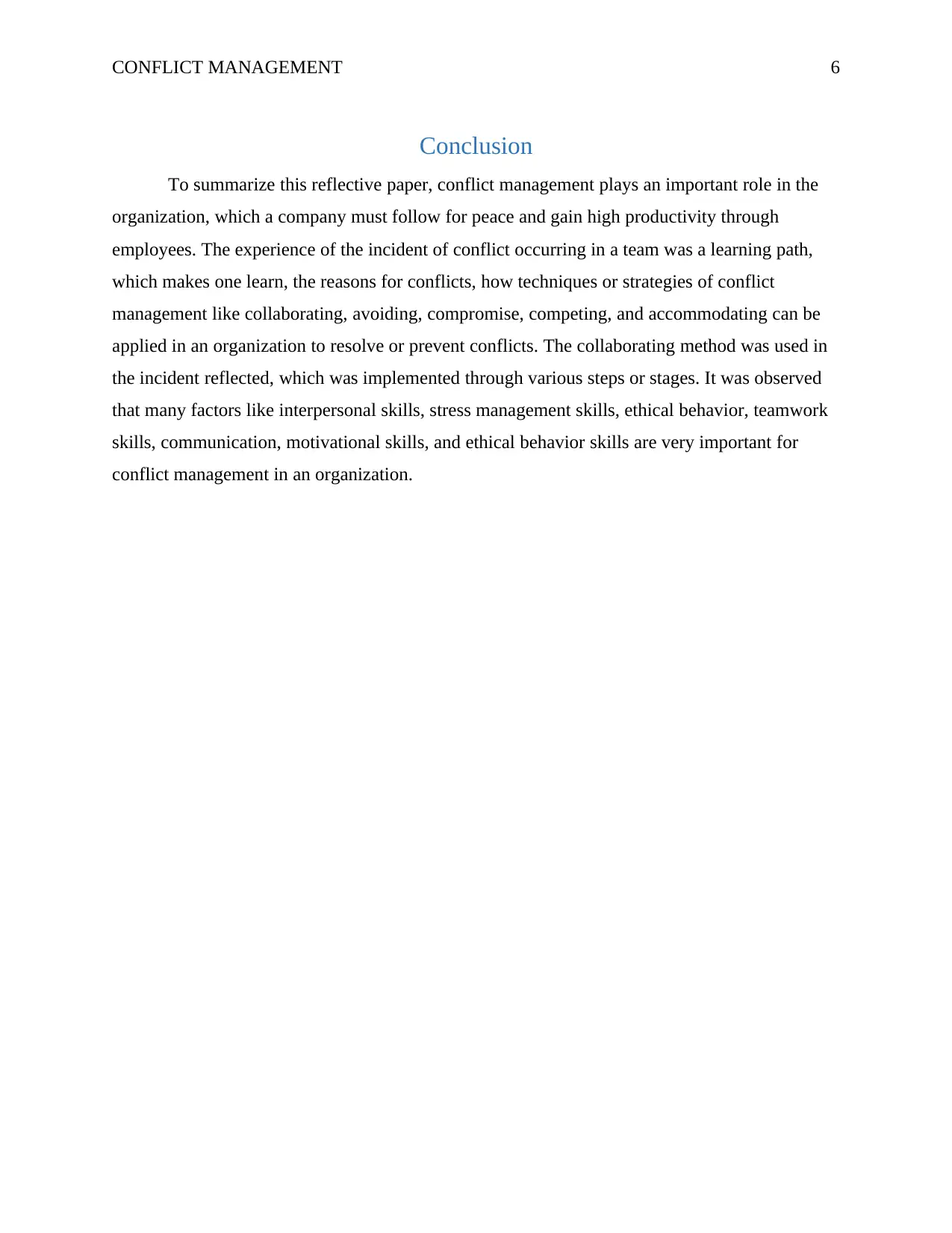
CONFLICT MANAGEMENT 6
Conclusion
To summarize this reflective paper, conflict management plays an important role in the
organization, which a company must follow for peace and gain high productivity through
employees. The experience of the incident of conflict occurring in a team was a learning path,
which makes one learn, the reasons for conflicts, how techniques or strategies of conflict
management like collaborating, avoiding, compromise, competing, and accommodating can be
applied in an organization to resolve or prevent conflicts. The collaborating method was used in
the incident reflected, which was implemented through various steps or stages. It was observed
that many factors like interpersonal skills, stress management skills, ethical behavior, teamwork
skills, communication, motivational skills, and ethical behavior skills are very important for
conflict management in an organization.
Conclusion
To summarize this reflective paper, conflict management plays an important role in the
organization, which a company must follow for peace and gain high productivity through
employees. The experience of the incident of conflict occurring in a team was a learning path,
which makes one learn, the reasons for conflicts, how techniques or strategies of conflict
management like collaborating, avoiding, compromise, competing, and accommodating can be
applied in an organization to resolve or prevent conflicts. The collaborating method was used in
the incident reflected, which was implemented through various steps or stages. It was observed
that many factors like interpersonal skills, stress management skills, ethical behavior, teamwork
skills, communication, motivational skills, and ethical behavior skills are very important for
conflict management in an organization.
Paraphrase This Document
Need a fresh take? Get an instant paraphrase of this document with our AI Paraphraser
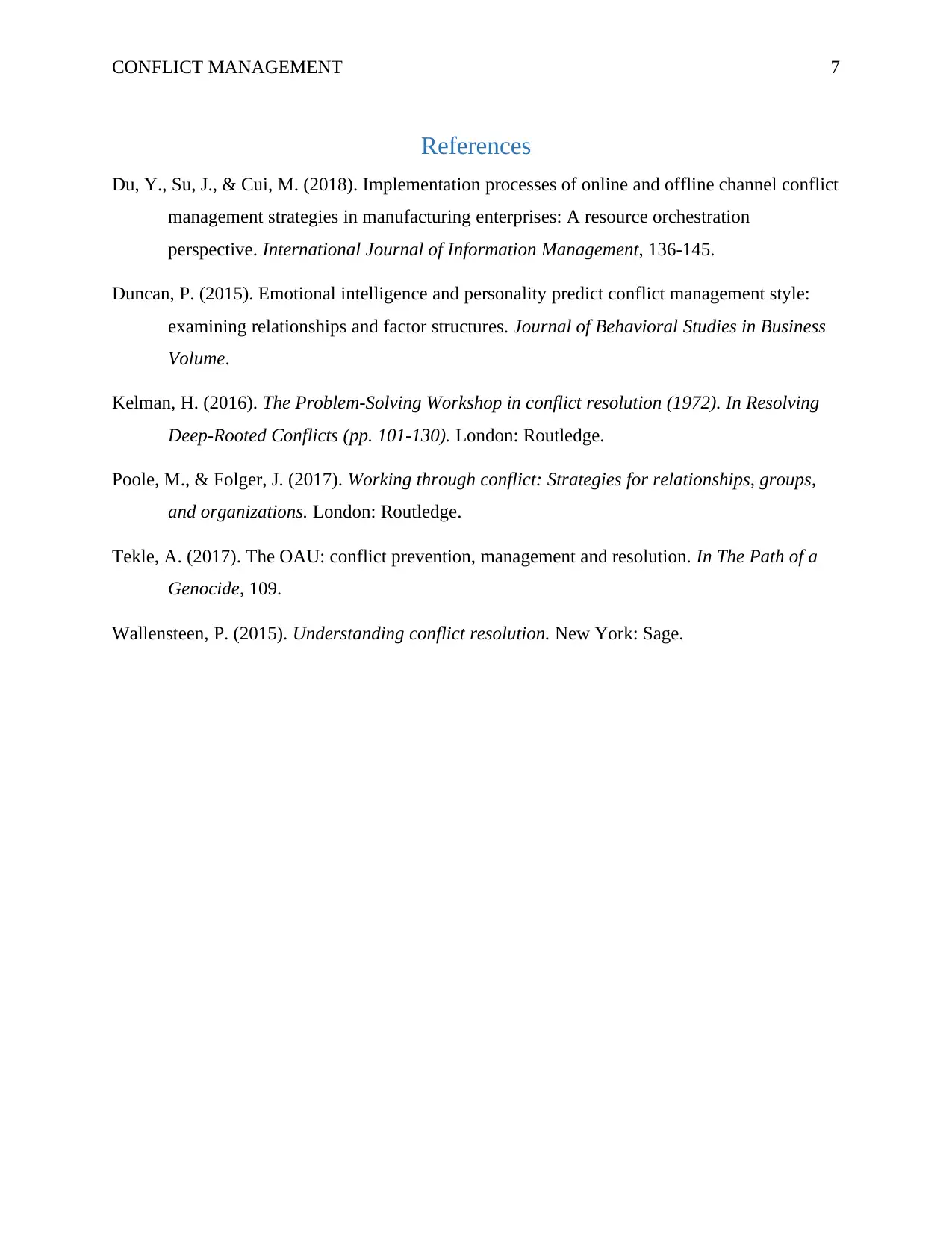
CONFLICT MANAGEMENT 7
References
Du, Y., Su, J., & Cui, M. (2018). Implementation processes of online and offline channel conflict
management strategies in manufacturing enterprises: A resource orchestration
perspective. International Journal of Information Management, 136-145.
Duncan, P. (2015). Emotional intelligence and personality predict conflict management style:
examining relationships and factor structures. Journal of Behavioral Studies in Business
Volume.
Kelman, H. (2016). The Problem-Solving Workshop in conflict resolution (1972). In Resolving
Deep-Rooted Conflicts (pp. 101-130). London: Routledge.
Poole, M., & Folger, J. (2017). Working through conflict: Strategies for relationships, groups,
and organizations. London: Routledge.
Tekle, A. (2017). The OAU: conflict prevention, management and resolution. In The Path of a
Genocide, 109.
Wallensteen, P. (2015). Understanding conflict resolution. New York: Sage.
References
Du, Y., Su, J., & Cui, M. (2018). Implementation processes of online and offline channel conflict
management strategies in manufacturing enterprises: A resource orchestration
perspective. International Journal of Information Management, 136-145.
Duncan, P. (2015). Emotional intelligence and personality predict conflict management style:
examining relationships and factor structures. Journal of Behavioral Studies in Business
Volume.
Kelman, H. (2016). The Problem-Solving Workshop in conflict resolution (1972). In Resolving
Deep-Rooted Conflicts (pp. 101-130). London: Routledge.
Poole, M., & Folger, J. (2017). Working through conflict: Strategies for relationships, groups,
and organizations. London: Routledge.
Tekle, A. (2017). The OAU: conflict prevention, management and resolution. In The Path of a
Genocide, 109.
Wallensteen, P. (2015). Understanding conflict resolution. New York: Sage.
1 out of 8
Related Documents
Your All-in-One AI-Powered Toolkit for Academic Success.
+13062052269
info@desklib.com
Available 24*7 on WhatsApp / Email
![[object Object]](/_next/static/media/star-bottom.7253800d.svg)
Unlock your academic potential
Copyright © 2020–2025 A2Z Services. All Rights Reserved. Developed and managed by ZUCOL.





